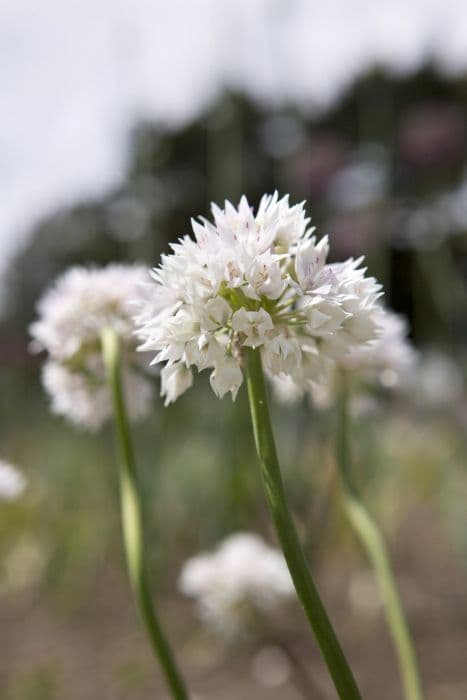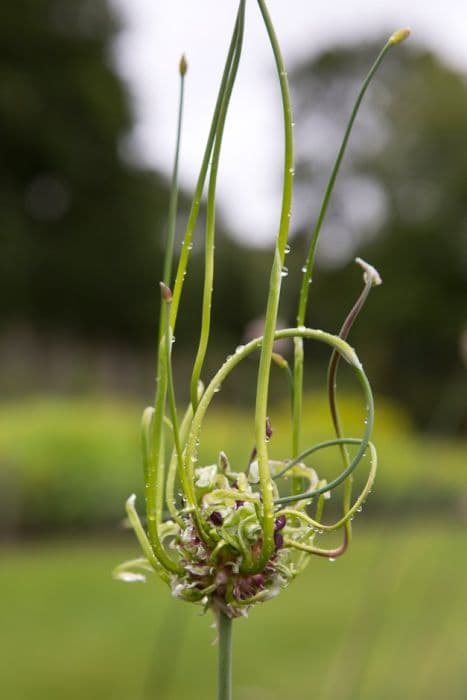Spring Starflower Ipheion 'Rolf Fiedler'

ABOUT
The Ipheion 'Rolf Fiedler' is adorned with eye-catching, star-shaped flowers in a striking shade of blue that typically draws attention in any setting where it's planted. Each individual blossom comprises six pointed petals that are slightly curved, coming together to form a harmonious and delicate starry shape. Contributing to the plant's allure are the prominent golden-yellow centers, which provide a beautiful contrast to the blue petals and serve to attract various pollinators. The foliage of Ipheion 'Rolf Fiedler' is equally appealing, characterized by slender, grass-like leaves. These leaves, which emerge in a lush clump, have a graceful arc and are a bright green in color, adding to the plant's overall texture and visual interest. The vivid green of the leaves also sets off the blue flowers, making them appear even more vibrant. Together, the blue flowers and green foliage create an aesthetic that is refreshing and spirited, and this plant often becomes a highlight in gardens when it is in full bloom. It is a plant that, despite its unassuming size, makes a significant impact with its colorful display.
About this plant
 Names
NamesFamily
Amaryllidaceae
Synonyms
Rolf Fiedler Spring Starflower, Rolf Fiedler Starflower
Common names
Tristagma uniflorum, Nothoscordum uniflorum, Brodiaea uniflora, Milla uniflora.
 Toxicity
ToxicityTo humans
The plant commonly known as Spring Starflower, specifically the Ipheion 'Rolf Fiedler' cultivar, is generally not reported to be toxic to humans. There are no well-documented cases of poisoning from consuming any part of this plant. However, as with any plant not meant for consumption, it is advisable to avoid ingesting it, as individual reactions can vary.
To pets
Similar to its effects on humans, the Spring Starflower is not widely recognized as a toxic plant to pets. It does not typically appear on lists of plants that are poisonous to pets such as cats and dogs. Nevertheless, it is always recommended to prevent pets from ingesting plants, as individual animals might have specific sensitivities or reactions.
 Characteristics
CharacteristicsLife cycle
Perennials
Foliage type
Deciduous
Color of leaves
Green
Flower color
Blue
Height
0.5 feet (15 cm)
Spread
0.5 feet (15 cm)
Plant type
Bulb
Hardiness zones
5
Native area
South America
Benefits
 General Benefits
General Benefits- Low Maintenance: Ipheion 'Rolf Fiedler', or commonly known as spring starflower, requires minimal care, making it ideal for gardeners of all levels.
- Drought Tolerant: Once established, the spring starflower can withstand periods of dryness, which is beneficial for water conservation.
- Attracts Pollinators: The bright blue-violet flowers attract bees and other pollinators, supporting local ecosystems.
- Deer Resistant: This plant is typically not preferred by deer, preventing damage to the garden from grazing.
- Pest Resistant: Spring starflower tends to be resistant to many common garden pests, reducing the need for chemical treatments.
- Naturalizing: It naturalizes well, spreading to form dense clumps that can cover large areas with minimal intervention.
- Seasonal Interest: Blooms in early spring offering a splash of color after a long winter.
- Easy to Divide: Clumps can be easily divided to propagate and share with others or to expand the garden.
- Versatile Planting: Suitable for borders, rock gardens, and underplanting beneath shrubs and trees.
- Container Friendly: Can be grown in pots or containers for those with limited space or for adding accents to patios and balconies.
 Medical Properties
Medical PropertiesThis plant is not used for medical purposes.
 Air-purifying Qualities
Air-purifying QualitiesThis plant is not specifically known for air purifying qualities.
 Other Uses
Other Uses- Photography Subject: The star-shaped, bright blue flowers of the Ipheion 'Rolf Fiedler' can provide a stunning subject for macro photography, capturing the intricate details and vibrant colors.
- Artistic Inspiration: Artists may choose to use this plant as inspiration for watercolors, drawings, and other forms of botanical art due to its visually appealing flowers.
- Educational Model: Schools and educational institutions might use Ipheion 'Rolf Fiedler' to teach students about plant biology, reproduction, and the life cycle of bulbous plants.
- Eco-Friendly Confetti: Dried petals of the Ipheion 'Rolf Fiedler' can be used as a biodegradable confetti alternative in celebrations, reducing plastic waste.
- Natural Dye: The blue pigments of the flowers could potentially be used to create natural dyes for fabric, yarn, or paper.
- Garden Design: Ipheion 'Rolf Fiedler' can be used in landscaping to create patterns and borders due to its clumping growth habit and contrasting flower color.
- Culinary Garnish: While not commonly eaten, the flowers can be used as an edible garnish to add a splash of color to salads and desserts for special occasions.
- Seasonal Indicator: The plant's flowering period can provide gardeners with a natural indicator of the coming of spring or changes in seasonal weather patterns.
- Aromatherapy: The light, onion-like scent of the leaves may be considered for use in aromatherapy blends, though it is an unconventional choice.
- Symbol of Awareness: As gardeners grow Ipheion 'Rolf Fiedler,' they can use the plant as a symbol to promote awareness for conservation of plant biodiversity.
Interesting Facts
 Feng Shui
Feng ShuiThe Spring Starflower is not used in Feng Shui practice.
 Zodiac Sign Compitability
Zodiac Sign CompitabilityThe Spring Starflower is not used in astrology practice.
 Plant Symbolism
Plant Symbolism- Resilience: Ipheion 'Rolf Fiedler', commonly known as Spring Starflower, often symbolizes resilience as it is a hardy plant that can withstand challenging conditions and still produce delicate blooms.
- Hope: The Spring Starflower is one of the early bloomers, heralding the arrival of spring. It is often associated with hope and the anticipation of better things to come following the winter season.
- New Beginnings: With its early spring flowers, the Spring Starflower symbolizes new beginnings and fresh starts, making it a perfect representation of the rejuvenating power of nature.
- Charm and Attractiveness: The bright blue to violet flowers of the Spring Starflower are symbolically linked to charm and attractiveness, reflecting its appealing appearance in gardens and natural settings.
 Water
WaterFor the spring starflower, consistent moisture is key, especially during its growth season in spring. Water the plant when the top inch of the soil feels dry, typically once a week. Use a watering can to gently water the soil around the plant, avoiding overhead watering that can dampen the foliage. Provide about half a gallon of water per plant to thoroughly moisten the soil without causing waterlogging. During dormant periods in the late summer or fall, reduce watering frequency as the plant requires less moisture.
 Light
LightSpring starflowers prefer full to partial sunlight conditions. The ideal spot for these plants is a location where they can receive at least four to six hours of direct sunlight each day. They can tolerate some shade, especially in hot climates, but too much shade can lead to weak growth and fewer blooms.
 Temperature
TemperatureSpring starflower thrives in temperatures between 50°F and 75°F, which are common in spring and autumn. They can survive minimal frosts and short periods of cold down to around 20°F but perform best when it's not too hot or cold. The plant is not well-suited to sustained temperatures over 80°F, as extreme heat can inhibit blooming and growth.
 Pruning
PruningPrune spring starflowers after they have finished flowering, usually in late spring or early summer, to remove spent blossoms and encourage a tidy appearance. Regular pruning is not mandatory since the plant naturally maintains a neat shape. Deadheading the faded flowers can sometimes stimulate a second bloom and should be done as flowers fade.
 Cleaning
CleaningAs needed
 Soil
SoilThe best soil mix for the Spring Starflower should be well-draining with a mix of loam, sand, and compost to provide nutrients. The soil pH should be slightly acidic to neutral, ranging from 6.0 to 7.5 to ensure proper growth.
 Repotting
RepottingSpring Starflower bulbs should be repotted every 2-3 years to prevent overcrowding and to replenish the soil. It's best to repot after the plant has finished flowering and has entered a period of dormancy.
 Humidity & Misting
Humidity & MistingSpring Starflowers prefer average humidity levels consistent with outdoor conditions. They are not particularly humidity-sensitive, and standard room humidity is typically sufficient when grown indoors.
 Suitable locations
Suitable locationsIndoor
Place in well-lit area, ensure pot has good drainage, and avoid overwatering.
Outdoor
Full sun to partial shade, well-drained soil, protect from extreme cold.
Hardiness zone
5-9 USDA
 Life cycle
Life cycleIpheion 'Rolf Fiedler', often called the 'Rolf Fiedler spring starflower', begins its life as a bulb that lies dormant underground during the summer. In late autumn, the bulbs develop roots and foliage, preparing for the upcoming growth period. By early spring, the foliage grows more substantially and is soon followed by the emergence of star-shaped, blue flowers that bloom until late spring. After flowering, the plant goes through a period of seed production if pollination occurs, then the above-ground foliage starts to yellow and wither. Throughout late spring and early summer, the plant goes into dormancy, withdrawing energy back into the bulb as the foliage dies back completely. The dormant bulb remains underground until the cycle restarts in the autumn, with the plant requiring minimal care during its rest period.
 Propogation
PropogationPropogation time
Spring to Summer
Ipheion 'Rolf Fiedler', commonly known as the spring starflower, is typically propagated by division of bulbs. The best time to propagate this plant is in late summer or early fall, after the foliage has died back. To propagate, carefully lift the clump of bulbs from the ground using a spade or fork. Gently separate the small, offset bulbs from the main bulb, ensuring that each new bulb has a portion of the base plate to grow from. These offsets can be replanted immediately, about 3 inches apart and with the top of the bulb just below the surface of the soil. Within a few seasons, these bulbs will multiply and can be divided again to create new plants, continuing the cycle of propagation.








